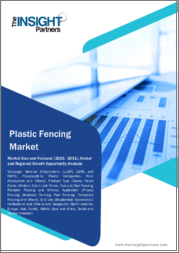
|
시장보고서
상품코드
1481348
플라스틱 펜스 시장 규모 : 재료별, 제품 유형별, 최종 용도별, 예측(2024-2032년)Plastic Fencing Market Size, By Material (Polyethylene, Vinyl Fencing, Composite Fencing), By Product (Panels & Sheets, Posts & Rails, Palings, Gates, Pickets, Chain Link Fences) By End Use (Residential, Commercial, Industrial), Forecast 2024 - 2032 |
||||||
플라스틱 펜스 시장 규모는 주택, 상업, 산업 각 분야에서 내구성이 높고 유지보수가 적은 펜스 솔루션에 대한 수요가 높아지고 있는 것을 배경으로 2024-2032년에 CAGR 6.3% 초과를 기록할 것으로 보이고 있습니다.
예를 들어 Abel & Cole은 2023년 10월 미국 최초의 세척 및 리필이 가능한 플라스틱 우유병을 출시하여 소비자에게 추가 비용 없이 여러 번 리필할 수 있다는 점을 강조하였습니다. 목재나 금속과 같은 전통적인 재료와 달리 플라스틱 펜스는 부패, 부식, 해충에 강해 장기적으로 비용 효율적인 투자가 될 수 있습니다. 친환경적이고 지속가능한 제품에 대한 관심이 높아지면서 플라스틱 펜스에 대한 수요는 더욱 높아질 것으로 보입니다.
또한 정부 규제의 유입으로 재활용 가능한 재료의 사용을 촉진하고 유해한 화학 물질로 처리된 목재의 사용을 제한하고 있습니다. 플라스틱 펜스는 프라이버시 울타리부터 장식적인 스타일까지 다양한 옵션이 있으며, 다양한 고객에게 더욱 매력적으로 다가갈 수 있습니다. 또한 설치와 커스터마이징이 용이하기 때문에 다양한 용도로 플라스틱 펜스의 채택이 늘어날 것으로 보입니다.
제품 유형별로 보면 플라스틱 펜스 시장의 패널 및 시트 부문은 2032년까지 3.4%의 연평균 복합 성장률(CAGR)을 나타낼 것으로 예상됩니다. 패널 및 시트는 주거용에서 상업용, 산업용에 이르기까지 다양한 사양과 용도에 맞게 쉽게 커스터마이징할 수 있는 다재다능한 울타리 솔루션을 제공합니다. 제조 기술의 발전으로 강도와 미적 감각이 향상된 패널 시트도 개발되고 있습니다.
최종 용도별로는 내구성과 안전성, 낮은 유지보수를 우선시하는 울타리 솔루션을 필요로 하는 경우가 많기 때문에 2024-2032년 산업 부문의 플라스틱 펜스 시장 가치는 7.4%의 성장률을 나타낼 것으로 예상됩니다. 플라스틱 펜스는 부식, 부패, 해충에 강해 시설과 자산을 장기적으로 보호해야 하는 산업 분야에 이상적인 선택입니다. 또한 플라스틱 펜스가 제공하는 확장성 및 맞춤형 옵션은 경계 보안, 출입 통제, 안전 구역과 같은 산업 환경의 특수한 요구를 충족시킬 수 있습니다.
아시아태평양의 플라스틱 펜스 산업은 중국, 인도, 동남아시아 국가 등의 급속한 도시화와 인프라 개발 구상에 힘입어 2024-2032년 연평균 8.1%의 높은 성장률을 나타낼 것으로 예상됩니다. 인구 증가와 가처분 소득 증가는 건설 부문의 성장을 가속하고 내구성이 높고 비용 효율적인 울타리 재료에 대한 수요를 촉진하고 있습니다. 환경 보호 및 지속가능한 개발에 대한 엄격한 규제는 이 지역의 산업 성장을 더욱 촉진할 것으로 보입니다.
목차
제1장 조사 방법과 조사 범위
제2장 주요 요약
제3장 업계 인사이트
- 에코시스템 분석
- 밸류체인에 영향을 미치는 요인
- 이익률 분석
- 파괴
- 향후 전망
- 제조업체
- 유통업체
- 소매업체
- 원재료 분석
- 규제 상황
- 업계에 대한 영향요인
- 촉진요인
- 업계의 잠재적 리스크 & 과제
- 성장 가능성 분석
- 소비자 구매 행동 분석
- 인구 동향
- 구매 결정에 영향을 미치는 요인
- 소비자의 제품 채택
- 선호되는 유통 채널
- 선호도의 가격 띠
- Porter의 산업 분석
- PESTEL 분석
제4장 경쟁 구도
- 기업 점유율 분석
- 경쟁 포지셔닝 매트릭스
- 전략 전망 매트릭스
제5장 시장 추정·예측 : 재료별, 2018-2032년
- 주요 동향
- 폴리에틸렌
- 비닐 펜스
- 복합 펜스
제6장 시장 추정·예측 : 제품 유형별, 2018-2032년
- 주요 동향
- 패널·시트
- 포스트·레일
- 책(Palings)
- 게이트
- Pickets
- 체인 링크 펜스
제7장 시장 추정·예측 : 최종 용도별, 2018-2032년
- 주요 동향
- 주택
- 상업
- 산업
제8장 시장 추정·예측 : 지역별,2018-2032년
- 주요 동향
- 북미
- 미국
- 캐나다
- 유럽
- 영국
- 독일
- 프랑스
- 이탈리아
- 스페인
- 아시아태평양
- 중국
- 인도
- 일본
- 한국
- 호주
- 라틴아메리카
- 브라질
- 멕시코
- 중동 및 아프리카
- 남아프리카공화국
- 사우디아라비아
- 아랍에미리트
제9장 기업 개요
- Active yards
- Barrette Outdoor Living
- Bufftech
- Certain Teed Corporation
- Durafence
- ITOCHU Corporation
- Pexco LLC
- Planet Polynet
- Ply Gem Holding Inc
- Seven Trust
- Superior Plastic Products
- Tenax
- VEKA Group
Plastic fencing market size is set to record over 6.3% CAGR between 2024 and 2032, driven by the increasing demand for durable and low-maintenance fencing solutions among residential, commercial, and industrial sectors. For example, in October 2023, Abel & Cole, introduced the U.K.'s inaugural washable and refillable plastic milk bottle, emphasizing its ability to be refilled numerous times without added expense to consumers. Unlike traditional materials like wood or metal, plastic fencing resists rot, corrosion, and pests, making it a cost-effective long-term investment. The rising emphasis on eco-friendly and sustainable products will further fuel the demand for plastic fencing.
The influx of government regulations is also promoting the use of recyclable materials and restricting the use of wood treated with harmful chemicals. The versatility of plastic fencing, with options ranging from privacy fences to decorative styles is further appealing to a diverse range of customers. Moreover, the ease of installation and customization will drive the adoption of plastic fencing across various applications.
The overall industry is classified into material, product, end use and region.
Based on product type, the panels & sheets segment in the plastic fencing market is slated to record 3.4% CAGR through 2032. Panels & sheets offer a versatile fencing solution that can be easily customized to fit various specifications and applications, ranging from residential to commercial and industrial settings. Advancements in manufacturing technology have also led to the development of panels & sheets with enhanced strength and aesthetic appeal.
In terms of end use type, the plastic fencing market value from the industrial segment is anticipated to observe 7.4% growth rate during 2024 and 2032, as they often require fencing solutions that prioritize durability, security, and low maintenance. Plastic fencing resists corrosion, rot, and pests, making it an ideal choice for industrial applications for ensuring long-term protection for facilities and assets. The scalability and customization options offered by plastic fencing also caters to the specific needs of industrial environments like perimeter security, access control, or safety delineation.
Asia Pacific plastic fencing industry will grow substantially at 8.1% CAGR between 2024 and 2032, attributed to rapid urbanization and infrastructure development initiatives across countries like China, India, and Southeast Asian nations. The increasing population coupled with rising disposable incomes are fostering the growth of the construction sector, which in turn is fueling the demand for durable and cost-effective fencing materials. Stringent regulations regarding environmental conservation and sustainable development will further stimulate the regional industry growth.
Table of Contents
Chapter 1 Methodology & Scope
- 1.1 Market scope & definitions
- 1.2 Base estimates & calculations
- 1.3 Forecast calculations
- 1.4 Data sources
- 1.4.1 Primary
- 1.4.2 Secondary
- 1.4.2.1 Paid sources
- 1.4.2.2 Public sources
Chapter 2 Executive Summary
- 2.1 Industry 360 degree synopsis, 2018-2032
Chapter 3 Industry Insights
- 3.1 Industry ecosystem analysis
- 3.1.1 Factor affecting the value chain
- 3.1.2 Profit margin analysis
- 3.1.3 Disruptions
- 3.1.4 Future outlook
- 3.1.5 Manufacturers
- 3.1.6 Distributors
- 3.1.7 Retailers
- 3.2 Raw material analysis
- 3.3 Regulatory landscape
- 3.4 Industry impact forces
- 3.4.1 Growth drivers
- 3.4.2 Industry pitfalls & challenges
- 3.5 Growth potential analysis
- 3.6 Consumer buying behavior analysis
- 3.6.1 Demographic trends
- 3.6.2 Factors affecting buying decision
- 3.6.3 Consumer product adoption
- 3.6.4 Preferred distribution channel
- 3.6.5 Preferred price range
- 3.7 Porter's analysis
- 3.8 PESTEL analysis
Chapter 4 Competitive Landscape, 2023
- 4.1 Company market share analysis
- 4.2 Competitive positioning matrix
- 4.3 Strategic outlook matrix
Chapter 5 Market Estimates & Forecast, By Material, 2018-2032 (USD Billion) (Million units)
- 5.1 Key trends
- 5.2 Polyethylene
- 5.3 Vinyl fencing
- 5.4 Composite fencing
Chapter 6 Market Estimates & Forecast, By Product Type, 2018-2032 (USD Billion)
- 6.1 Key trends
- 6.2 Panels & sheets
- 6.3 Posts & rails
- 6.4 Palings
- 6.5 Gates
- 6.6 Pickets
- 6.7 Chain link fences
Chapter 7 Market Estimates & Forecast, By End Use, 2018-2032 (USD Billion) (Million units)
- 7.1 Key trends
- 7.2 Residential
- 7.3 Commercial
- 7.4 Industrial
Chapter 8 Market Estimates & Forecast, By Region, 2018-2032 (USD Billion)
- 8.1 Key trends
- 8.2 North America
- 8.2.1 U.S.
- 8.2.2 Canada
- 8.3 Europe
- 8.3.1 UK
- 8.3.2 Germany
- 8.3.3 France
- 8.3.4 Italy
- 8.3.5 Spain
- 8.4 Asia Pacific
- 8.4.1 China
- 8.4.2 India
- 8.4.3 Japan
- 8.4.4 South Korea
- 8.4.5 Australia
- 8.5 Latin America
- 8.5.1 Brazil
- 8.5.2 Mexico
- 8.6 MEA
- 8.6.1 South Africa
- 8.6.2 Saudi Arabia
- 8.6.3 UAE
Chapter 9 Company Profiles
- 9.1 Active yards
- 9.2 Barrette Outdoor Living
- 9.3 Bufftech
- 9.4 Certain Teed Corporation
- 9.5 Durafence
- 9.6 ITOCHU Corporation
- 9.7 Pexco LLC
- 9.8 Planet Polynet
- 9.9 Ply Gem Holding Inc
- 9.10 Seven Trust
- 9.11 Superior Plastic Products
- 9.12 Tenax
- 9.13 VEKA Group















